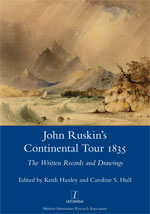John Ruskin's Continental Tour 1835
The Written Records and Drawings
Edited by Keith Hanley and Caroline S. Hull
Click cover to enlarge Buy hardback at: Buy paperback at: Booksellers & libraries: | Legenda 19 December 2016 • 308pp ISBN: 978-1-906540-85-2 (hardback) • RRP £80, $110, €95 ISBN: 978-1-781883-00-6 (paperback, 30 September 2018) • RRP £13.49, $17.99, €16.49 ISBN: 978-1-781883-01-3 (JSTOR ebook) Access online: Books@JSTOR ModernEnglishArtstudent-priced In addition to its original library hardback edition, this title is now on sale in the new student-priced Legenda paperback range. John Ruskin's training as an interdisciplinary polymath started in childhood. He learned to memorise the Bible at his mother's knee and published his first poem aged ten. His lifelong fascination with geology found its earliest expression in journal articles from the age of fifteen, while his considerable talents as a draughtsman were developed by leading drawing masters before he was sixteen. Rather than being a prodigy in one particular field, it was his precocious mix of religion, science and art that laid the foundations for the fulfilment of his career as a critic of art, architecture and society. The cultural tours that he made with his family as he grew up provided the crucial focus for these developing interests, and the second extended tour of the Continent in 1835 at the age of sixteen in particular established the paradigm for his orchestrated representation and analysis of cultural experience along 'the old road', through France to Chamonix, and through the Swiss Alps to northern Italy as far as Venice. His diary of the journey and associated writings, together with numerous drawings he made in relation to it, are annotated and fully catalogued for the first time in this edition that includes maps and an introductory essay. Keith Hanley is Professor of English Literature at Lancaster University, where he directed the Ruskin Centre, 2000-08. His books include John Ruskin's Romantic Tours, 1837-1838: Travelling North (Edwin Mellen Press, 2007) and, with J. K. Walton, Constructing Cultural Tourism: John Ruskin and the Tourist Gaze (Channel View, 2010). Co-edited collections include: with R. Dickinson, Ruskin's Struggle for Coherence: Self-Representation through Art, Place and Society (Cambridge Scholars Press, 2008); with E. Sdegno, Ruskin, Venice and Nineteenth-Century Cultural Travel (Le Bricole, 2010); and with Brian Maidment, Persistent Ruskin: Studies in Influence, Assimilation and Effect (Ashgate, 2013). Caroline Hull studied the History of Art at Princeton and Yale Universities and has taught undergraduate and postgraduate students in the United States and the UK. With her husband, Andrew Jotischky, Professor of Medieval History at Lancaster University, she has co-written The Penguin Historical Atlas of the Medieval World (2005) and The Penguin Historical Atlas of the Bible Lands (2009). She has contributed to a number of academic publications and co-curated several exhibitions primarily focusing on ecclesiastical art and architecture. Currently Caroline is a regional manager for an international Catholic charity. John Ruskin's Continental Tour 1835 is the winner of the 2017 Ruskin Society Prize.
Reviews:
Contents:
Bibliography entry: Hanley, Keith, and Caroline S. Hull (eds), John Ruskin's Continental Tour 1835: The Written Records and Drawings (Legenda, 2016) First footnote reference: 35 John Ruskin's Continental Tour 1835: The Written Records and Drawings, ed. by Keith Hanley and Caroline S. Hull (Legenda, 2016), p. 21. Subsequent footnote reference: 37 Hanley and Hull, p. 47. (To see how these citations were worked out, follow this link.) Bibliography entry: Hanley, Keith, and Caroline S. Hull (eds). 2016. John Ruskin's Continental Tour 1835: The Written Records and Drawings (Legenda) Example citation: ‘A quotation occurring on page 21 of this work’ (Hanley and Hull 2016: 21). Example footnote reference: 35 Hanley and Hull 2016: 21. (To see how these citations were worked out, follow this link.) This title is distributed on behalf of MHRA by Ingram’s. Booksellers and libraries can order direct from Ingram by setting up a free ipage® Account: click here for more. Permanent link to this title: www.mhra.org.uk/publications/John-Ruskins-Continental-Tour-1835 | ||||||||||||||||||||||||||||||||||||||||||||||||||||||||||||||||||||||||


